|
Lighting the Nights of
Christmas
by Bob Brooke
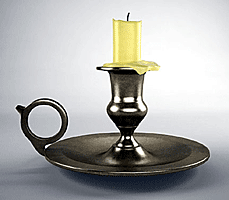 Antique
candlesticks are favorites among collectors. Beautifully crafted,
they create an intimate and memorable setting, especially during the
Christmas holidays. Their twinkling light offers hope during long
winter nights. Antique
candlesticks are favorites among collectors. Beautifully crafted,
they create an intimate and memorable setting, especially during the
Christmas holidays. Their twinkling light offers hope during long
winter nights.
Humans have always needed fire for food, safety, and especially for
light during dark nighttime hours. Archaeologists have discovered
the remains of ancient candles made from animal fat or beeswax
throughout the Middle East and Asia. But holding a burning candle
soon proved to be problematic. Users needed something to hold the
candle safely, and the candleholder was born.
Early Candleholders
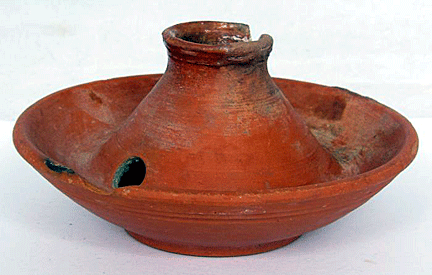 At
first people used crude holders of clay but over the centuries, the
design and function of candlesticks became ever more sophisticated.
Later candlesticks benefited from centuries of ingenious improvements
that occurred during the 17th century. Both the stem and the base of
candlesticks used to be made of solid brass. It was common for examples
of that era to have a hole in the socket to remove the candle stump
which would frequently get stuck. However, the 18th century brought a
wave of innovation in candlestick design. First, instead of being
constructed in solid brass, craftsmen made candleholders in two vertical
halves. At
first people used crude holders of clay but over the centuries, the
design and function of candlesticks became ever more sophisticated.
Later candlesticks benefited from centuries of ingenious improvements
that occurred during the 17th century. Both the stem and the base of
candlesticks used to be made of solid brass. It was common for examples
of that era to have a hole in the socket to remove the candle stump
which would frequently get stuck. However, the 18th century brought a
wave of innovation in candlestick design. First, instead of being
constructed in solid brass, craftsmen made candleholders in two vertical
halves.
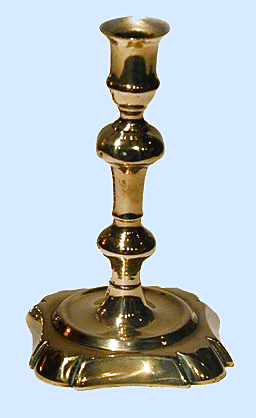 Brazing
them together left a hollow space inside and a line from the softer
brazing material. This space allowed the addition of slide ejectors with
a handle on the side or push-rod ejectors underneath the base. Both of
these would push the tail end of the candle up the stem, allowing it to
be easily removed. Makers further simplified the process by casting the
stem in one piece using a removable core which allowed for a much finer
and thinner product. Brazing
them together left a hollow space inside and a line from the softer
brazing material. This space allowed the addition of slide ejectors with
a handle on the side or push-rod ejectors underneath the base. Both of
these would push the tail end of the candle up the stem, allowing it to
be easily removed. Makers further simplified the process by casting the
stem in one piece using a removable core which allowed for a much finer
and thinner product.
By the beginning of the 18th century, candlesticks had become spun and
hand-tooled brass accessories needed by every household. Some were
simple, but many featured a plain stem threaded to a square base with a
shallow dished drip catcher. While single candlesticks had a wide range
of uses and could easily be carried about the house after sunset,
larger, more ornate multiple candleholders or candelabra began to appear
on dining tables, servers, and mantels in later 18th-century homes.
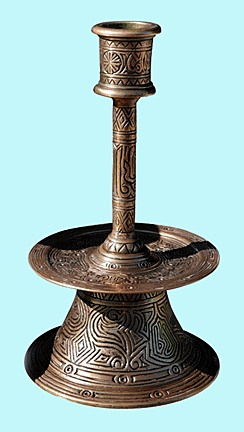 The
form of the candlestick has also gone through several transformations.
Until middle of the 18th century, most candlesticks had large drip pans
– a vertical plane attached to the middle of a candlestick to prevent
the candle from dribbling. Candlestick makers often placed these half
way up the column to protect the hand from hot melted wax. The
form of the candlestick has also gone through several transformations.
Until middle of the 18th century, most candlesticks had large drip pans
– a vertical plane attached to the middle of a candlestick to prevent
the candle from dribbling. Candlestick makers often placed these half
way up the column to protect the hand from hot melted wax.
However, as the candles began to be produced from a superior quality of
tallow, these drip pans became no longer necessary, and the candlestick
stem could be decorated with increasingly intricate designs. During the
Queen Anne period, candlesticks had an octagonal shaped stem and round
base without decoration. Early Georgian examples were also quite elegant
and plain, perhaps with hexagonal or cut-corners base. During the
mid-18th century, French Rococo influences transformed the candlestick
stem.
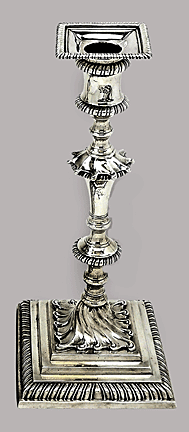 Georgian
candlesticks were masterpieces of floral decorations, asymmetrical
designs brought into being by casting the base from independent pieces
and soldering and chasing it afterwards. Later Georgian candlesticks
featured gadrooned rims or baluster shaped stem with a series of knops.
The bases, previously only round or square, were shaped into petal,
swirl or scallop designs. By the reign of King George III of England,
many more elaborate candlesticks featured fluted tapered Neoclassical
columns threaded to incurved pyramidal bases. Georgian
candlesticks were masterpieces of floral decorations, asymmetrical
designs brought into being by casting the base from independent pieces
and soldering and chasing it afterwards. Later Georgian candlesticks
featured gadrooned rims or baluster shaped stem with a series of knops.
The bases, previously only round or square, were shaped into petal,
swirl or scallop designs. By the reign of King George III of England,
many more elaborate candlesticks featured fluted tapered Neoclassical
columns threaded to incurved pyramidal bases.
To celebrate the Diamond Jubilee of Queen Victoria, James Clews and Sons
of Birmingham designed a series of candlesticks that were first made in
1897. They were the ‘Ace of Diamonds, ‘King of Diamonds’ and ‘Queen of
Diamonds’ and the designs proved so popular that they were still in
production until the start of the war in 1939. Each candlestick has the
name stamped on the base.
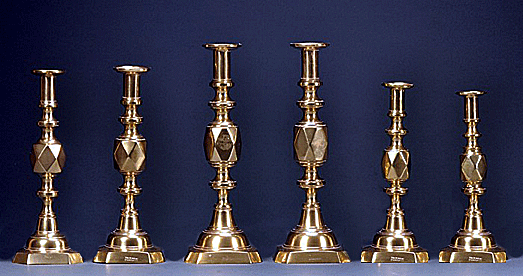
Tapersticks
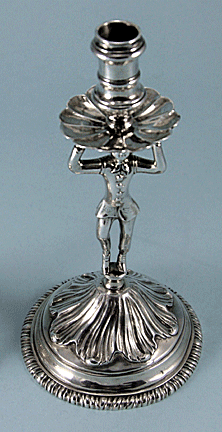 Tapersticks
were small table candlesticks designed to hold a wax taper, a small thin
tapered tallow candle. Many tapersticks were miniature copies of the
period table candlesticks of the time. Early examples had minimal
decoration and simple waisted sockets. By the mid 18th century styles
had evolved to include gadrooning, fluting and other examples of Rococo
decoration. Tapersticks
were small table candlesticks designed to hold a wax taper, a small thin
tapered tallow candle. Many tapersticks were miniature copies of the
period table candlesticks of the time. Early examples had minimal
decoration and simple waisted sockets. By the mid 18th century styles
had evolved to include gadrooning, fluting and other examples of Rococo
decoration.
People frequently needed these small tapers during daily 18th century
life when they first became popular. Inkstands often included
tapersticks since senders sealed most letters with wax melted over the
small tallow candle flames and then impressed with an intaglio carved
with initials or the family crest. Tapersticks also served as
chambersticks, as they were small and light and easy to carry from room
to room, as well as for the purpose of lighting other candlesticks or
for the lighting of tobacco.
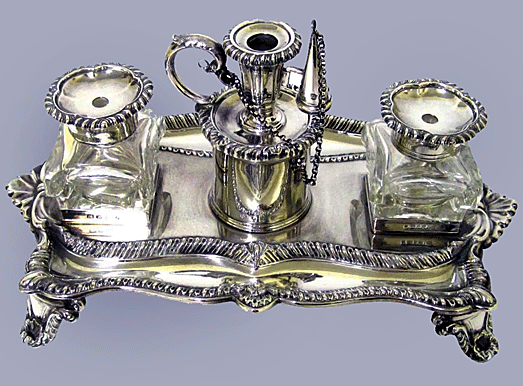
Tapersticks are much rarer than the larger table candlesticks since few
existed before the reign of Queen Anne. Because of their most common
uses, candlestick makers generally made them individually, making pairs
extremely rare.
The Candle Snuffer
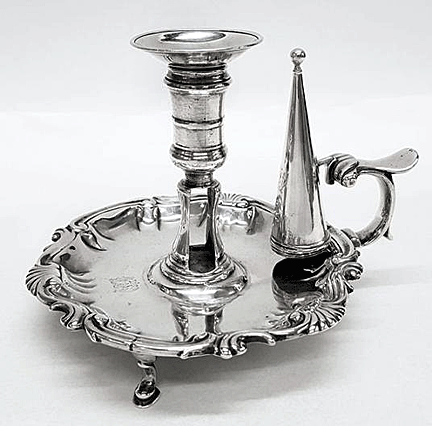 As
candlesticks became more sophisticated in the mid-18th century, people
required a method to safely put out candles without blowing them. While
the candle snuffer's component parts—scissors, a stand, dustpan—might be
familiar to some people, combined, they do look strange. However, before
electricity, candles and candle snuffers were an integral part of
everyday life. Candle wicks used to be made of cotton which would start
smoking and burst into flames as they grew longer, therefore
necessitating regular trimming. The scissor part of the candle snuffer
would sever the burnt wick, which would safely fall into the dustpan to
be extinguished and discarded. This would also catch any dripping hot
wax. As
candlesticks became more sophisticated in the mid-18th century, people
required a method to safely put out candles without blowing them. While
the candle snuffer's component parts—scissors, a stand, dustpan—might be
familiar to some people, combined, they do look strange. However, before
electricity, candles and candle snuffers were an integral part of
everyday life. Candle wicks used to be made of cotton which would start
smoking and burst into flames as they grew longer, therefore
necessitating regular trimming. The scissor part of the candle snuffer
would sever the burnt wick, which would safely fall into the dustpan to
be extinguished and discarded. This would also catch any dripping hot
wax.
Christopher Pinchbeck the Younger invented and patented the candle
snuffer in England in 1776. His device actually looks like a pair of
stunted scissors with a raised round bowl atop them. The idea was to
snip the wick, which was caught in the bowl and extinguish the candle
safely with no soot or wax on the walls from blowing, or hot wicks
catching anything afire. According to some reports, it was a sign of
candle skill to be able to use the snuffer to trim a wick without
extinguishing the flame. The device was still being produced in
Birmingham, England until the 1970s.
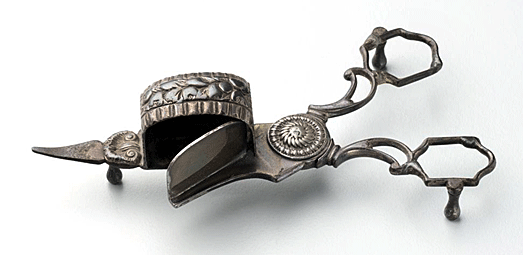
Traditionally, craftsmen made all snuffers, douters, and extinguishers
of brass, copper, or pewter and elaborately engraved many of them. That
tradition, of creating a functional work of pewter art, continues in
modern candle snuffers today, with their delicately twisted handles,
basket woven cones, or beautifully etched patterns.
<
Back to More Antique Spotlights
Next Article >
|
